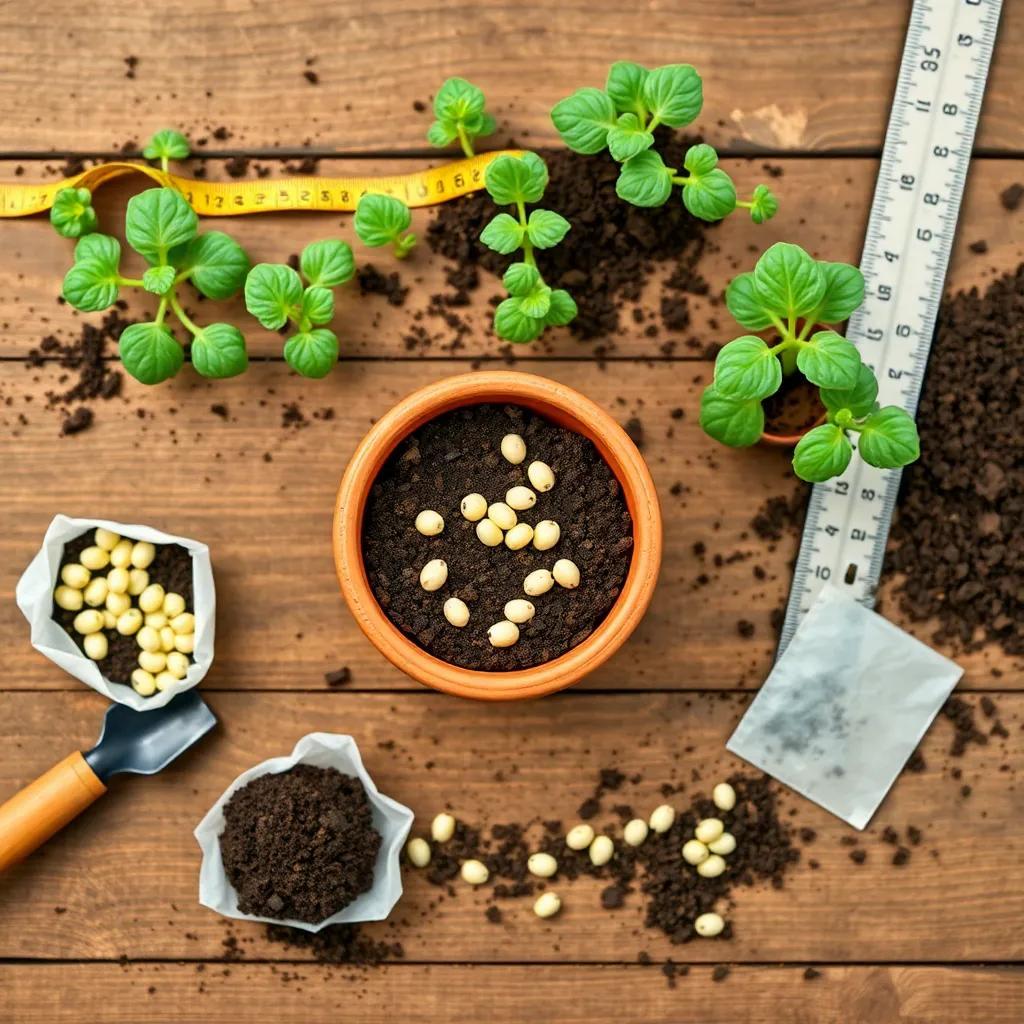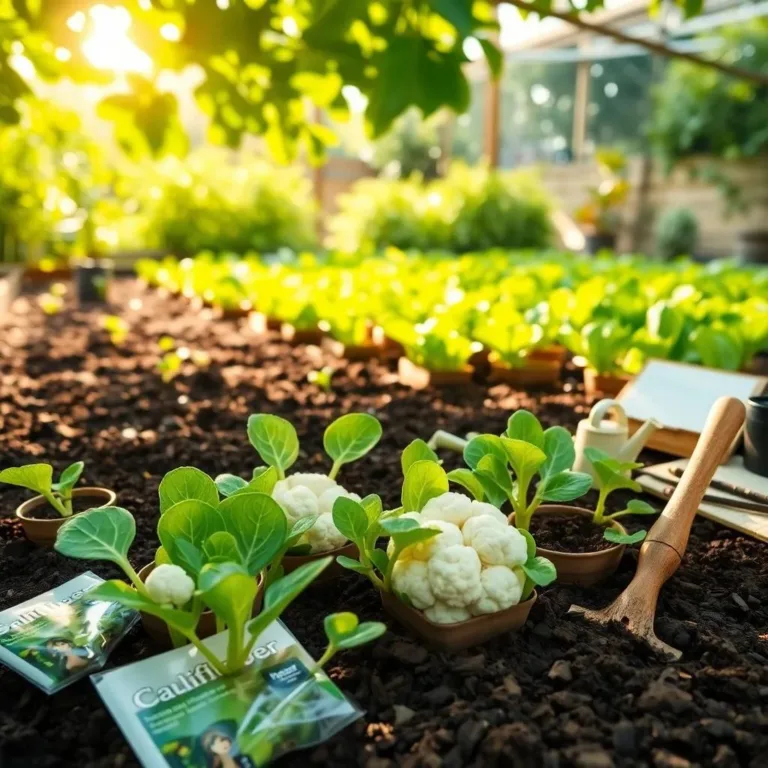Are you ready to grow some amazing cauliflower? I’m excited to share my tips and tricks for planting and caring for this delicious vegetable! Whether you’re a seasoned gardener or just starting out, you’ll find everything you need to know to cultivate healthy cauliflower plants that will impress your family and friends! Let’s dig into it!
Factors Influencing Cauliflower Seed Depth
When it comes to planting cauliflower seeds, the depth at which I sow them can really make a difference! Several factors play a role in determining the perfect planting depth. Let’s break them down so we can be on the same page!
- Seed Size: Cauliflower seeds are quite small. Generally, smaller seeds need to be planted more shallowly than larger seeds. For cauliflower, aiming for about 1/4 to 1/2 inch deep helps them sprout effectively.
- Soil Moisture: The moisture level of the soil is super important! If the soil is too dry, those little seeds might not get enough water and could struggle to germinate. On the flip side, if it’s too wet, the seeds could rot. Finding that happy medium is key, so keep an eye on moisture when deciding how deep to plant!
- Temperature: Cauliflower loves to chill out in cooler temperatures. The soil temperature should be around 50°F (10°C) for best results. When the soil is warm, seeds may need to be planted slightly deeper to help protect them from heat that can dry them out!
- Climate Conditions: Weather can be unpredictable! In windy or rainy areas, it can help to plant seeds a tad deeper to give them a protective barrier. This way, they’re less likely to get washed away or blown around.
- Soil Quality: Finally, let’s chat about soil. Well-draining soil is a must for cauliflower. If your soil is heavy or clay-like, planting a bit deeper may help the seeds access the moisture and nutrients they need.
By keeping these factors in mind, I can make informed choices on how deep to plant my cauliflower seeds. After all, a little planning goes a long way toward a bountiful harvest!
Recommended Depth for Cauliflower Seed Planting
Now that we’ve talked about the factors affecting planting depth, let’s get into the nitty-gritty of how deep to go with those cauliflower seeds! I’ve found that the recommended depth is around 1/4 to 1/2 inch. It sounds straightforward, right? But let’s break it down a bit more.
- 1/4 inch deep: This depth is perfect for those who want to give their seeds a gentle push into the soil. When I plant at this depth, I make sure to cover the seeds lightly with soil, just enough to keep them cozy!
- 1/2 inch deep: If the weather is a little unpredictable or if I’m working with particularly light soil, I might go for this deeper option. A half inch can offer slightly more protection for the seeds.
It’s super important not to go too deep though. If I bury them deeper than recommended, they can have a hard time breaking through the surface. Imagine trying to dig your way out of a pile of pillows—exhausting, right?
Here are a few pointers for planting:
- Use a garden trowel or your fingers to make small holes.
- Place the seeds about 1-2 inches apart, depending on how many I want to grow.
- Cover them gently, making sure to firm the soil down for good seed-to-soil contact.
Remember, keeping the soil consistently moist after planting is key to getting those seeds germinating. A light misting or gentle watering can go a long way! I like to think of it as giving my seeds a little drink to wake them up!
Armed with these planting depths, I’m ready to give my cauliflower seeds the best chance at thriving! Happy planting!

Step-by-Step Instructions for Planting Cauliflower Seeds
Time to get our hands dirty and plant some cauliflower seeds! I love this part because it’s where the magic happens. Follow these simple steps to help pave the way for your future cauliflower harvest!
- Prepare the Soil: Start by cleaning up your garden space. Remove any weeds and rocks that may be lurking. Then, loosen the soil to about 8-10 inches deep. If your soil needs a little boost, mix in some compost or aged manure. It’s like giving my plants a nutritious breakfast!
- Mark the Rows: Decide where you want to plant your cauliflower. Using stakes or string, mark out rows about 24-36 inches apart. This gives each plant room to grow and thrive without crowding. Trust me, they’ll appreciate the extra space!
- Plant the Seeds: In each row, create small trenches or furrows about 1/4 to 1/2 inch deep, depending on the earlier discussions. Place the seeds about 1-2 inches apart in the furrows. Cover them lightly with soil and gently press down. This part is my favorite—like tucking them in for a nice nap!
- Water Gently: After planting, it’s time for a drink! Water the soil gently but thoroughly to make sure it’s moist. I like to use a spray nozzle to avoid washing away my carefully placed seeds.
- Monitor Conditions: Keep an eye on your little seedlings as they emerge. They should get around 6 hours of sunlight daily. You can also add a layer of mulch around the plants to help retain moisture and keep those pesky weeds at bay!
By following these steps, you’ll be on your way to growing healthy, robust cauliflower plants in no time! It’s so satisfying to see them sprout after all our hard work!
Tips for Successful Cauliflower Growth and Care
Now that our cauliflower seeds are planted and beginning to sprout, let’s talk about how to give them the best care possible! There’s a little bit of magic involved in nurturing these plants to ensure they grow strong and produce delicious heads.
- Water Consistently: Cauliflower loves moisture, so it’s important to check the soil regularly. Aim to keep it evenly moist, like a well-watered sponge. During dry spells, water deeply to keep those roots happy.
- Fertilize Wisely: Giving them a little extra love with some organic fertilizer can boost their growth. A balanced fertilizer works wonders! Just follow the package instructions, and don’t overdo it—nobody likes a party crasher!
- Control Pests: Uh-oh, pests can be a real issue! Keep an eye out for aphids, cabbage worms, and flea beetles. I like to check the leaves regularly for any signs of trouble. If I spot pests, I try using organic insecticides or introduce beneficial insects to help control them.
- Provide Adequate Sunlight: Cauliflower craves sunlight! Make sure they’re getting a minimum of 6 hours each day. If they’re not getting enough light, they might stretch out in search of it, making them weak and leggy.
- Mulching Matters: Applying a layer of mulch around the plants helps conserve moisture, regulate temperature, and suppress weeds. Plus, it gives my garden that tidy look!
With these tips, my cauliflower plants will thrive, and I’ll be one step closer to a bountiful harvest! Remember, a little attention goes a long way in producing those delicious heads of cauliflower!
Common Mistakes When Planting Cauliflower Seeds
As we dive into growing cauliflower, it’s important to avoid some common pitfalls. Trust me; I’ve made these mistakes before, and they can be a real headache! Let’s go over what to watch out for:
- Planting Too Deep: I used to think more was better! However, planting seeds too deep can stunt their growth. A depth of 1/4 to 1/2 inch is just right. Keep it shallow, my friends!
- Overwatering: While cauliflower loves moisture, overdoing it can lead to root rot. I like to check the soil moisture first! When it feels dry, give them a gentle watering.
- Crowded Plants: I’ve definitely crammed too many plants together before, thinking they could share space. But cauliflower needs room to grow! Make sure there’s 18-24 inches of space between each plant so they can spread out.
- Ignoring Soil Quality: Not all soil is created equal! Poorly draining soil can cause issues for our cauliflower. Always amend your soil with organic matter to create the perfect environment!
- Neglecting Pest Control: Pests can ruin all my hard work! I’ve learned the hard way to regularly check my plants for pests and diseases. A little vigilance can go a long way in keeping my plants healthy.
- Improper Harvesting: Timing is everything! I used to wait too long to harvest, which can lead to bitterness and dryness. I’ve learned to keep an eye on the heads and harvest them when they’re firm and fully developed.
By avoiding these common mistakes, I can nurture my cauliflower plants to their full potential! Happy gardening, and may your cauliflower thrive like never before!

